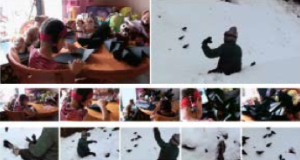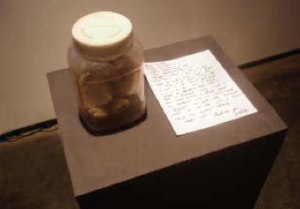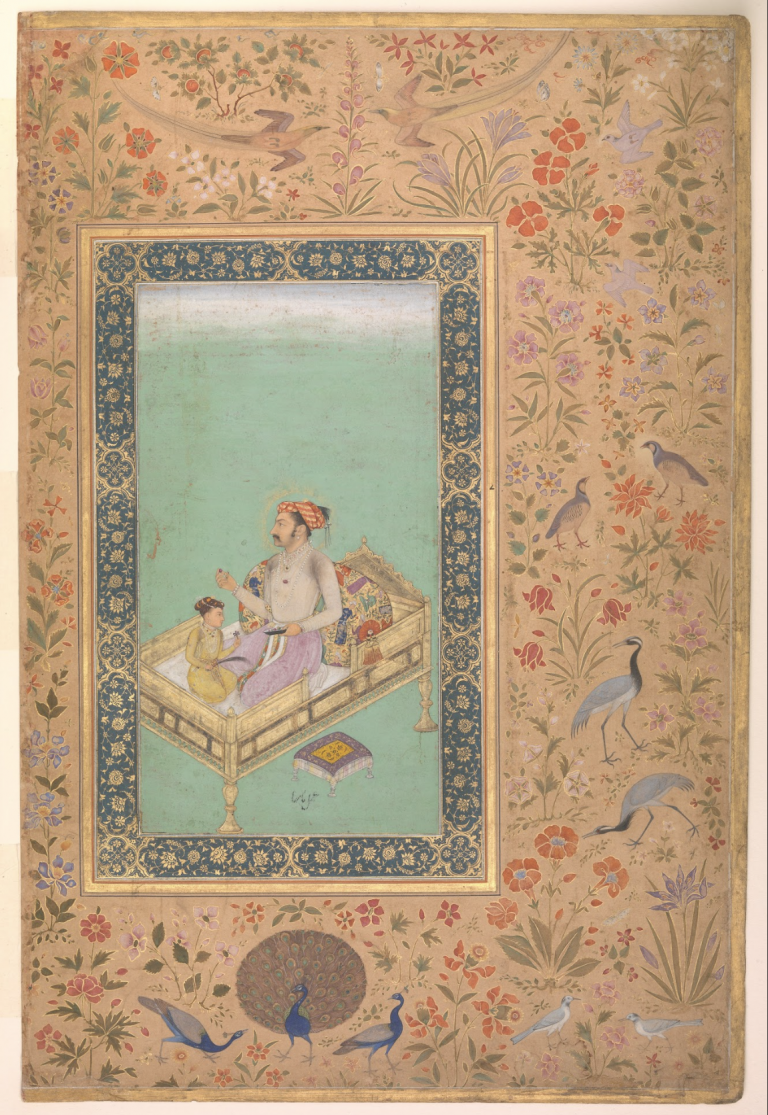A sunlit room – black paper airplanes overpower the colours that surround a young girl.
A snowed out landscape – a soldier flies black paper airplanes in vain.
A jar of air and stones – stands audience to the two terrains.
Baptist Coelho’s double channel video I Think of my brother’s only one child named Deepthi, reveals the aridness and the darker side of life on the highest battleground in the world – the twenty five year long ongoing conflict between India and Pakistan on the Siachen glacier.

Coelho brings out the stark distinction of space and colour by drawing constant comparisons. Cold, harsh, white light, with barren mountains and snow are contrasted with the warmth of a home, filled with familiar objects, colour and sunlight. Black paper airplanes dominate both these landscapes to break barriers of language, caste, and borders. A young girl, is surrounded by colour on her desk with stuffed toys begging for attention – but it is the folding of black paper airplanes that occupy her. There is a forced effort to cover everything with this dark creation. Her mind and eyes do not wander – she is fixed on masking her coloured world. There is a layering of surroundings and emotions as the young girl makes a conscious effort to block all colours around her. In Channel 2 of the video, a soldier flies these airplanes that effortlessly dash into nearby snow.
The soldier’s movement and the futile flight of paper planes signify dashed hopes and the helplessness of the situation that is reflected via the fragility of paper. The monotony of action emphasizes the slow passage of time.
On the snow clad landscape, even the colour black seems vibrant. The paper planes are shown in two contrasting terrains – the warmth of a house where they are manufactured and the barren, cold, white Siachen glacier where they are dashed into the snow. However, in the adjoining video, black is the dull colour of grief that surrounds a young girl’s colourful world– showing the starkness of sorrow, family bonding and the darker side of life. There is also a visual play of a soldier’s desire for colour and the warmth of home. Cautiously treading on political, personal and social issues, the artist successfully communicates the severity of the Siachen issue and its effects on not only the soldiers’ lives, but the influence on their families as well. Though Coelho questions politics, he does not involve it in his works. Conflicting issues run as deep under-currents that cannot be separated from the Siachen glacier. Despite these overpowering factors, Coelho’s works can be viewed as art outside politics, in a context of the humane.
Representing a family situation of a soldier in Siachen – Coelho shows how codes are the only means of communication. The link between home and the glacier are the black airplanes– No names can be used. Through this video installation, Coelho represents the loss of personal identity to achieve a national one. In Channel 2 of the video, the soldier’s back faces the screen. To the viewer he remains just another soldier without a face, without a personalized identity.
The title of the work I Think of my brother’s only one child named Deepthiwas developed from Coelho’s ongoing project of collecting bottles of air, from various places around the world.Each bottle contains a leaf and an accompanying note of the thoughts at the time the contributor sealed the air. The jarfrom Siachen contains only stones and no leaves, signifying the barrenness of the cold desert. As a part of the installation, this plastic jar of stones stands testimony to the double channel video. Accompanying the jar is a note by a soldier –Yuvarajun, when he was stationed at Khardung-La, the highest motorable road in the country. He mentions the representation of a family member, for each stone he put in. His last reference is to his“brother’s only one child named ‘Deepthi’…” Through these words, the soldier talks about his experience in conjunction tohis world and relationships outside of Siachen.

I Think of my brother’s only one child named Deepthi, embodies the artist’s prolific use of medium and is an ideal collation of his ongoing series of Air and Paper Airplanes. The medium of his works evolve from research based content, which gives the artist freedom to experiment with video, photography and installation. Connecting the universal with the local through airplanes, Coelho develops his ongoing projects on Air and paper Airplanes by linking the two in this double channel video installation with real evidence in a bottle of air and stones in a solemn disposition.
The jar of stones is a time capsule, a memory and a testament of life, which captures the essence of the barren place of conflict. This section of the work localizes the installation with the soldier’s personal note that describes his thoughts for each stone – in turn voicing the conditions and emotions in Siachen– and the way families and people’s lives have been affected by the Siachen issue.
Air as a medium, has been a prior pre-occupation with BaptistCoelho. Having worked with this resource as a specific object, the artist subtly incorporates it into his latest works to establish a link. Besides the jar of stones, the element of air prevails over the movement of the black paper airplanes in Channel 2 of the video. The soldier’s desperate effort to fly the airplanes further are in vain, as the strong gusts of air dart the paper airplanes into the snow. In Coelho’s initial series with paper airplanes (2008 onwards), he essentially used white, which was a neutral tone for the language of the works. However, in this work, the artist felt the need to codify the emotion of grief and sadness through the colour black. Coelho began working with airplanes as a reflection of his childhood toys, innocence and creativity.
In this double channel video installation, the origami planes become reminiscent of his childhood need to create and play, while the colour black plays the role of sorrow, grief and distance in an issue involving two nations.
(‘I Think of my brother’s only one child named, Deepthi’ was exhibited at Project 88, Mumbai; as a part of Baptist Coelho’s solo exhibition ‘You Can’t Afford to Have Emotions Out There…’ from 5th to 26th August 2009)













